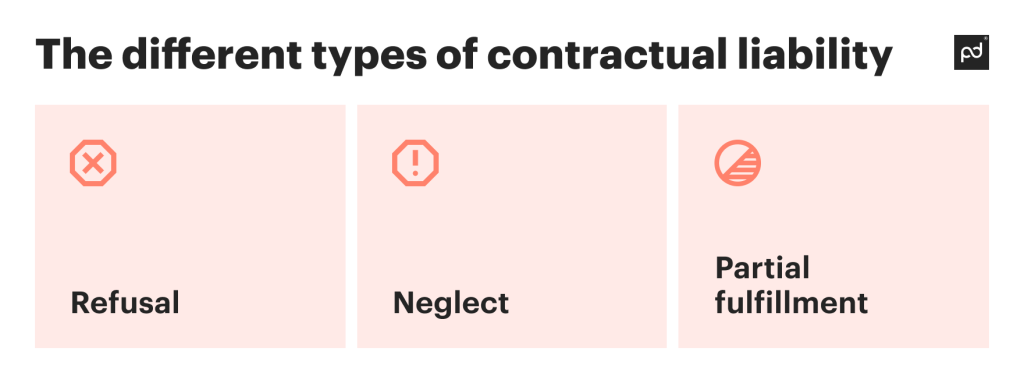‘With great power comes great responsibility,’
it’s like Spiderman’s Uncle Ben said. He probably wasn’t talking about contract liability, but as it happens, his famous quote does apply here.
In this article, we’ll be taking a closer look at the details surrounding contract liability to give you a complete understanding of the topic—but first, some key takeaways.
Key takeaways:
- Contract liability governs who’s responsible for what in a formal agreement and details what the parties’ obligations are.
- Liability contracts are versatile and can be used in a variety of situations.
- Another type of contract that deals with issues of responsibility is a release of liability, which involves one party being absolved of responsibility for another.
- Contracts dealing with liability should include several elements to make them watertight. It can be helpful to use a contract template to ensure you get it right.
What is contract liability?
No contract liability definition would be complete without explaining each term separately.
To that end, a contract is a legally binding document that two or more parties sign to signal that they intend to uphold its terms.
Liability, meanwhile, refers to one party essentially taking responsibility for something.
So, if Company A is liable for the actions of Company B, and someone at Company B gets hurt, Company A might agree to fund any care or treatment they need.
Contractual liability formalizes this agreement and ensures one party is legally accountable for something specific. Usually, this is either another party or their own actions.
It also explains what the liable party will do for those it’s responsible for and how it will express this responsibility.

Contractual liability comes into force when the terms of a contract aren’t upheld. There are three main kinds, which are crucial to know if you want to ensure effective contract generation.
Refusal
If a liable party outright refuses to honor the terms they agreed to, they can still be held liable. Saying “no” after the fact is not a valid way to opt out.
This means a non-liable party (or parties) can hold someone accountable even if they refuse to uphold the agreement.
Neglect
Maybe they didn’t say “no”, but in this instance, the liable party simply ignored their responsibilities. This can happen both on purpose and accidentally.
In either case, neglect isn’t an excuse and can lead to contractual liability being enforced.
Partial fulfillment
In some cases, a liable party might uphold some of the initial agreement but not all of it. This can create problems for the parties they’re liable to.
However, it’s important to note that signing a liability contract means someone is responsible for all the terms laid out in it, so partial fulfillment is unacceptable.
An example of contractual liability
Now, let’s illustrate how contractual liability works in practice using an example.
Say a software development company wants to upgrade its IT infrastructure. It hires a firm to help it do so. We’ll call the software company Mega and the business it hires SuperFirm.
SuperFirm is responsible for making sure Mega’s IT infrastructure is in top shape once it’s done with its upgrades. But it finds Mega has a lot of printers, which SuperFirm doesn’t normally work with.
So, SuperFirm sources a third-party company, BestPrinters, which specializes in this area. SuperFirm has BestPrinters sign a liability contract. This states that if Mega’s printers break or aren’t up to par, BestPrinters will be held responsible, not SuperFirm.
When one of the printers fails to switch on after the IT upgrade, Mega contacts BestPrinters, which sends someone out to fix the printer immediately.
In this example, everyone follows standard contract management best practices. If they hadn’t, the agreement would be used to settle any disputes and assign liability.
Release of liability contract: What is it, and when is it used?
A release of liability contract absolves a company or individual of contractual responsibility for another.
They’re often signed when a customer agrees to take responsibility for any injuries they might suffer while using the services on offer.
This sort of waiver may be utilized by outfits that provide activities that, by their nature, come with a degree of risk for the customer or client.
These include but are not limited to:
- Horseback riding
- Skiing or snowboarding
- Axe throwing
- Skydiving
- Rock climbing or bouldering
- Target shooting
- Full-contact sports like football
- Bungee jumping
Any customer that partakes in these activities after having signed a release of liability contract agrees not to seek legal action against the company if they’re hurt or injured as a result.
What to include in a release of liability contract template
A release of liability contract should include necessary clauses to reasonably and legally absolve a company of responsibility for any repercussions suffered by those who engage in the activities they offer.
Here’s a quick list of the kinds of items these types of templates should include.
- The Releasor, or the person who’s signing the contract. They’ll be taking responsibility for themselves.
- The Releasee, or the person/organization that’s handing over responsibility.
- The effective date when the contract begins or becomes legally binding.
- The events the releasor promises NOT to take legal action against, such as personal injury, accident, or death.
- Consideration, which outlines any compensation the releasor will receive.
- The governing law under which the contract will be signed. This typically also describes which laws will be used to handle any contract disputes.
Alongside these, certain optional items may also be included, such as:
- An assumption of risk for the releasor
- A statement that the releasor agrees to handle their own medical and insurance claims
- Parent or guardian signatures for minors
- Right to an attorney
Contract templates may vary from one to the next, but the above items are the most important elements to include.
How PandaDoc’s contract templates can help your business
Whether it’s for assigning contract liability or some other purpose, PandaDoc can help get your legal documents drafted and finalized in no time.
Our extensive template library helps make this happen — all you need to do is choose the best option and then enter your details.
This saves time and effort and ensures you create a legally binding document that’s fit for purpose.



